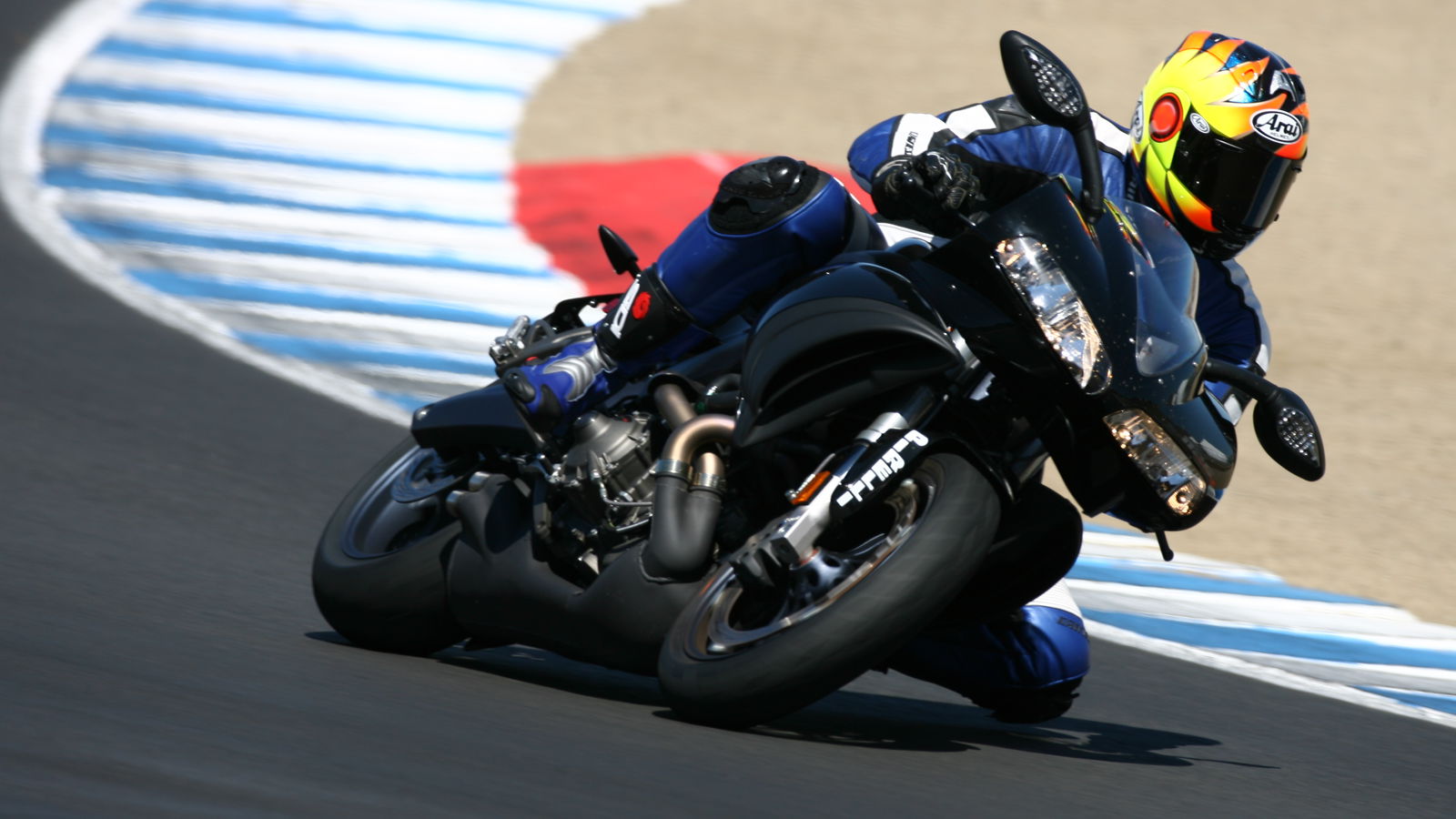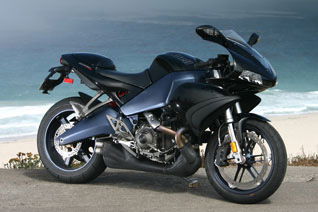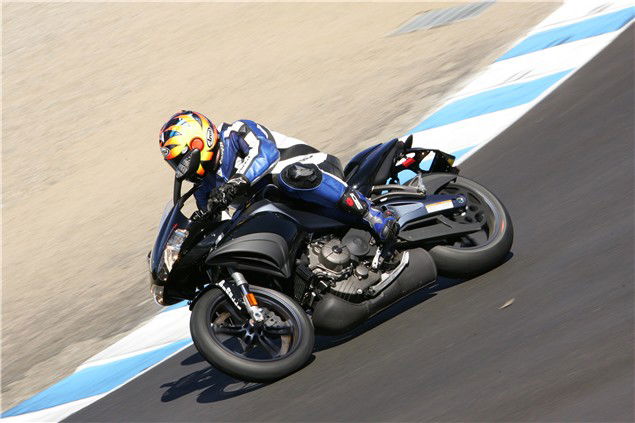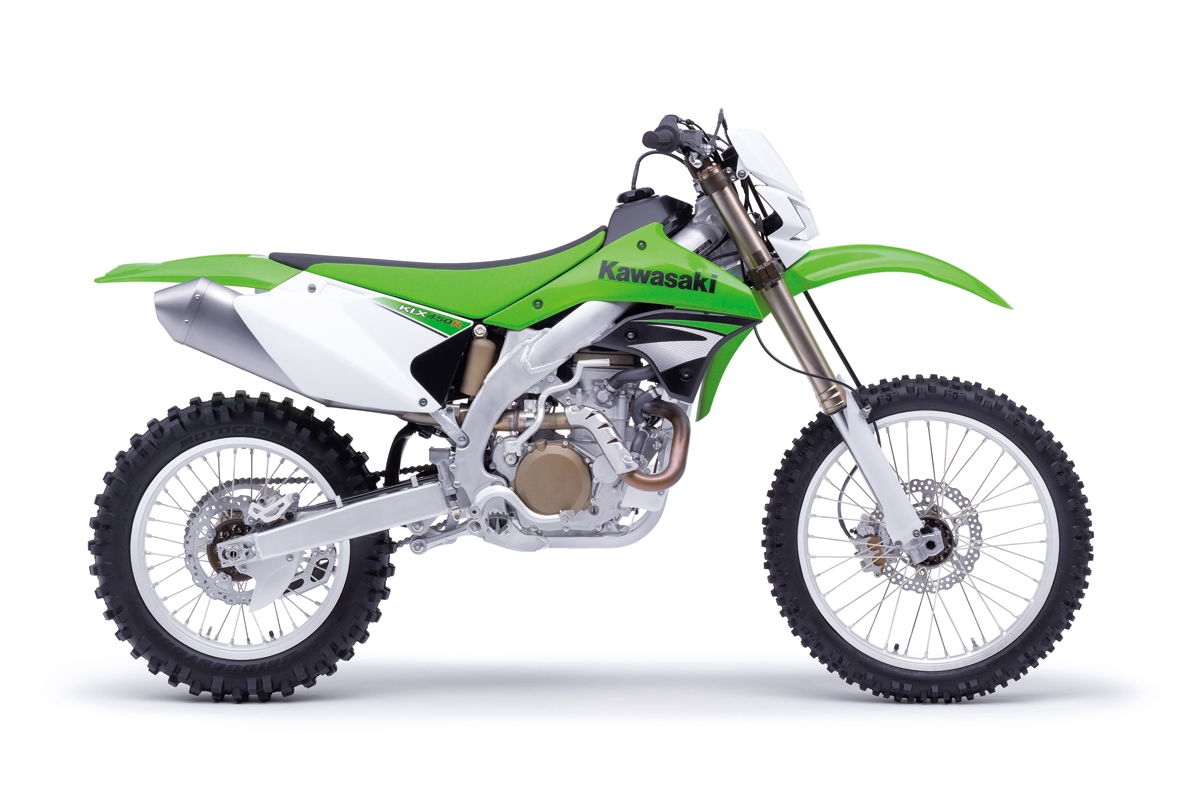First Ride: 2007 Buell 1125R
25 years in the making and Erik Buell finally makes the bike he always dreamed of: a liquid-cooled V-twin with plenty of poke and handling to die for. So has junking the Harley engines given Buell a new edge?

 |
"Turn six is the left hander before the Corkscrew. You don't need to go to the paint on the entry, hold it around three-quarters of the track width, then bring it back left so you can get the Corkscrew right. Don't worry about the Corkscrew itself: you'll enjoy it. Your stomach doesn't leap into your throat too much, but if it does this may be a slight problem given the sheer size of yours..."
It's nice to get some good advice on a track you've never seen before, even if it is a tad insulting. But TWO's columnist Colin Edwards has had a couple of good results around Laguna, home of the launch of the new Buell 1125R, so I thought he'd be the right person to ask. Thing is, despite it being my first lap, the advice is lost on me as the bike is conking out. A trip back to the pits reveals a flat battery. Apparently someone had left the ignition on yesterday. It's not a good start, because for Buell this is a Very Important Bike. By Buell I mean both Buell the company and Buell the man.
Ask the affable Erik why he built the new 1125R and he says: "This is the bike I've always wanted to build for the last 20 years. We've been successful with air-cooled engines, but using a liquid-cooled motor means we have finally become a full-blown sportsbike manufacturer." But truth be told, there were a few problems with the 1125R.
Over the two day test, one machine had a clutch problem, on another machine a wire was melted by it's position near an exhaust pipe so it quit, a brake disc 'warped', all bikes had scratches on the swingarms where boots were rubbing the paint off and all of us had to do the Buell 'hot-shoe shuffle' at one time or another, when very hot air was vented onto your right foot - don't ride this bike in trainers! And then there's the suspension weirdness around the track, where the bikes had to be set-up stiff as a board to handle. But more of that later.
Essentially the Buell 1125R is both a new beginning and an extension of what's gone before for the American marque. New as in we have a powerful, liquid-cooled motor and yet all the pleasant quirks and foibles that make Buells a curious joy to ride are there too. Fuel in frame: check, mass centralization:check, Zero Torsional Load front brake disc: check.
First impressions are good, thanks to that new motor, which was developed jointly between Rotax and Buell. Erik has long been a fan of V-twins thanks to their flexibility and it's this that hits home on your first ride of the 1125R. There's a beautifully broad spread of power from the 72-degree motor and around an unfamiliar track like Laguna it cossets you, as your gear selection needn't be spot-on.
Buell claims 146bhp @ 10,000rpm at the crank, but I reckon the 1125R will be pushing out more like 115 on the dyno. The bike is so tractable and flexible that from top gear and 2,500 revs it'll lurch, and maybe complain a little, but still pull you back up towards the redline. The motor behaves well out on the road or on the track. Sure, it's not silky smooth - it'll vibrate, cough and lurch a little at 4,000rpm - but you can play and leave it in one gear if you like, simply riding that wave of instant urge.
This is both good and bad: good as it's perfect for when you're in a lazy mood, bad because then you don't realise how good the gearbox is.
If you're used to Japanese, Italian or even British gearboxes then it's still a little heavy, but this gear change is a world away from Buells of yore. The brakes are superb, too. The new eight-pot caliper means less weight than a conventional dual-disc system and it works very well, hauling the whole 170 kilo machine up very nicely indeed. The only black mark we could find was when some sort of warping to the 375mm front disc led to judder and brake fade at the lever on one of the bikes.
Suspension is where things get a little murky for me. Now, I do a few trackdays a year, I consider myself 'vaguely respectable' rather than 'really rapid', but the way the Very Important Bike is behaving in the sessions at Laguna is puzzling me. In my first 'proper' session after pulling in with a duff battery, I'm on the 'big-boys' set-up Buell, as befits my largesse, and all is well. But come session two I'm on one set-up for a lighter load and it's making a big difference. The bike is porpoising from front to rear on the brakes and on the power and it's not feeling sure-footed in Laguna's demanding turns. Normally on most sportsbikes I can get on something with standard settings and be comfortable as I rarely fiddle with suspension settings, apart from a bit of preload, but around Laguna it seems that the 1125R needs to be pretty firmly suspended. So much so that most other riders were nicking my bike, resulting in most of us getting the Buell technicians to set up the remaining machines in a similar style.
In the morning Buell were saying that these machines were pre-production bikes, but then it came to light that they may well make suspension changes as they feel that they've had a bad batch of fork springs. I can forgive the bike this, so long as the production bikes have suspension that behaves as well as it did most of the time, you're onto a winner. But it does rather ask the question, 'why launch a bike and give journos pre-production machines?' That's just stupid.
Out on the road and with some lovely Californian roads the bike proved to be a real hit. The motor is a star out on the Tarmac, allowing you to leave it in any gear you like, knowing that it'll willingly pull if the bend opens up on you. With modern sportsbikes getting smaller and more uncomfortable, the Buell is a real breath of fresh air. Sure it's small, but there's plenty of comfort to be had from the ergonomics and that bulbous fairing does a good job of protecting you from the elements. One thing that was a genuine pain was the blast of very hot air, which seems to be pumped from the radiators down to your right foot at low rpm. It must be addressed before this bike hits the shops as it can be agony in trainers.
On reflection the Buell 1125R is a fine sportsbike but with a few serious issues. It's pokey, flickable and different and the looks do grow on you, even if the top fairing looks like a Ducati 916's that some daft Yank has measured out in inches rather than millimetres. It's a huge step-up for Buell from existing models and should do well in introducing some new customers to the Buell marque. After all, this is a completely different proposition to, say, a GSX-R750, although that's both good and bad news. While the 1125R is a real alternative to run-of-the-mill UJMs, that GSX-R is £500 cheaper, as practical on the road, better on the track and with a more rewarding engine. And that's going to be the Buell's biggest problem, at least in the UK. Why should I buy it?
Try to suspend your belief that all this technology doesn't work and go and test ride one of these. The 1125R is both different and defined. Let's just hope they'll have ironed out the not inconsiderable bugs before they hit the shops later this year, otherwise the new Buell will stay like it was in the Californian sunshine when I first saw it: shining bright from funny angles, like a flawed gem.
TECHNICAL INSIGHT ON THE 1125
Buell say they have a 'Trilogy of Tech' which is mass centralization, chassis rigidity and low unsprung weight.
The American firm has based the 1125R's specs firmly on these mantras, using the 'innovations' from the air-cooled XB series, such as fuel in the frame, rim-mounted brake disc and under-belly exhaust, "...which the Japanese are now copying with their bikes, we were the first, way back in 1985," says Erik himself. One thing missing from the older air-cooled bikes is oil in the swingarm, that's now integrated in the dry sump.
Much of the 1125R comes from the XBRR Formula Extreme race bike, the top fairing comes from the same 'virtual' wind-tunnel, as does the eight-pot rim-mounted brakes.
It's the motor that's the biggest departure though, being liquid-cooled. The 1125cc Helicon motor is a 72-degree engine with dual overhead cams and a narrow 14-degree valve angle for improved downdraft intake. The motor also has a hydraulic vacuum assist slipper clutch and a ram-air system. To keep things smooth on the inside, the Rotax-developed motor has three balancer shafts, while to keep things smooth on the outside, 61mm throttle bodies ensure a linear power curve. Suspension is Showa front and rear, with 47mm inverted forks and a piggy-back reservoir monoshock, and both units are fully adjustable. Wheels are six-spoke lightweight cast aluminium items.
SPECS
TYPE - SUPERSPORTS
PRODUCTION DATE - 2007
PRICE NEW - £8495
ENGINE CAPACITY - 1125cc
POWER - 146bhp@9800rpm
TORQUE - 82lb.ft@8000rpm
WEIGHT - 179kg
SEAT HEIGHT - 775mm
FUEL CAPACITY - 21.2L
TOP SPEED - 150mph
0-60 - n/a
TANK RANGE - N/A

"Turn six is the left hander before the Corkscrew. You don't need to go to the paint on the entry, hold it around three-quarters of the track width, then bring it back left so you can get the Corkscrew right. Don't worry about the Corkscrew itself: you'll enjoy it. Your stomach doesn't leap into your throat too much, but if it does this may be a slight problem given the sheer size of yours..."
It's nice to get some good advice on a track you've never seen before, even if it is a tad insulting. But TWO's columnist Colin Edwards has had a couple of good results around Laguna, home of the launch of the new Buell 1125R, so I thought he'd be the right person to ask. Thing is, despite it being my first lap, the advice is lost on me as the bike is conking out. A trip back to the pits reveals a flat battery. Apparently someone had left the ignition on yesterday. It's not a good start, because for Buell this is a Very Important Bike. By Buell I mean both Buell the company and Buell the man.Ask the affable Erik why he built the new 1125R and he says: "This is the bike I've always wanted to build for the last 20 years. We've been successful with air-cooled engines, but using a liquid-cooled motor means we have finally become a full-blown sportsbike manufacturer." But truth be told, there were a few problems with the 1125R.
Over the two day test, one machine had a clutch problem, on another machine a wire was melted by it's position near an exhaust pipe so it quit, a brake disc 'warped', all bikes had scratches on the swingarms where boots were rubbing the paint off and all of us had to do the Buell 'hot-shoe shuffle' at one time or another, when very hot air was vented onto your right foot - don't ride this bike in trainers! And then there's the suspension weirdness around the track, where the bikes had to be set-up stiff as a board to handle. But more of that later.
Essentially the Buell 1125R is both a new beginning and an extension of what's gone before for the American marque. New as in we have a powerful, liquid-cooled motor and yet all the pleasant quirks and foibles that make Buells a curious joy to ride are there too. Fuel in frame: check, mass centralization:check, Zero Torsional Load front brake disc: check.
First impressions are good, thanks to that new motor, which was developed jointly between Rotax and Buell. Erik has long been a fan of V-twins thanks to their flexibility and it's this that hits home on your first ride of the 1125R. There's a beautifully broad spread of power from the 72-degree motor and around an unfamiliar track like Laguna it cossets you, as your gear selection needn't be spot-on.
Buell claims 146bhp @ 10,000rpm at the crank, but I reckon the 1125R will be pushing out more like 115 on the dyno. The bike is so tractable and flexible that from top gear and 2,500 revs it'll lurch, and maybe complain a little, but still pull you back up towards the redline. The motor behaves well out on the road or on the track. Sure, it's not silky smooth - it'll vibrate, cough and lurch a little at 4,000rpm - but you can play and leave it in one gear if you like, simply riding that wave of instant urge.
This is both good and bad: good as it's perfect for when you're in a lazy mood, bad because then you don't realise how good the gearbox is.

